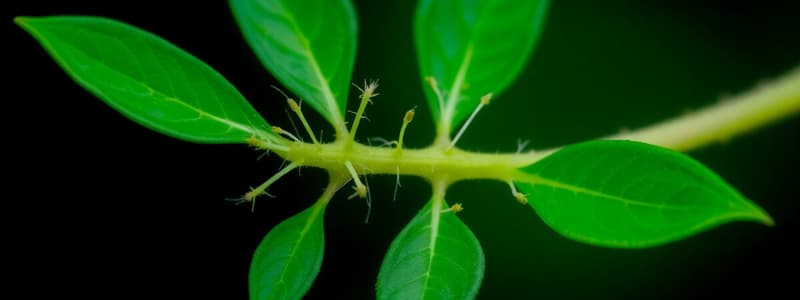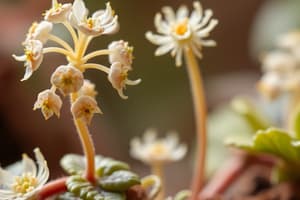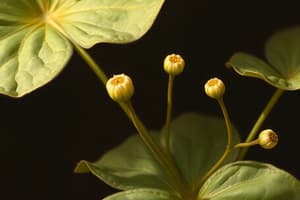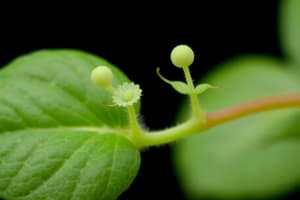Podcast
Questions and Answers
Which of the following accurately describes the roles of the vascular cambium and cork cambium in secondary growth?
Which of the following accurately describes the roles of the vascular cambium and cork cambium in secondary growth?
- The vascular cambium produces cork and phelloderm, while the cork cambium produces secondary xylem and phloem.
- The vascular cambium produces secondary xylem to the interior and secondary phloem to the exterior, while the cork cambium produces cork to the exterior and phelloderm to the interior. (correct)
- The vascular cambium initiates primary growth, with the cork cambium continuing secondary growth.
- Both the vascular cambium and the cork cambium produce secondary xylem to the interior and secondary phloem to the exterior.
Why does early wood typically have larger diameter cells and thinner walls compared to late wood?
Why does early wood typically have larger diameter cells and thinner walls compared to late wood?
- To maximize water delivery to new, expanding leaves in the spring. (correct)
- To minimize water loss during the hot summer months hence thicker walls.
- To provide increased physical support during the winter months.
- To store excess nutrients produced during the growing season.
What is the primary function of the waxy material deposited in the cell walls of cork cells?
What is the primary function of the waxy material deposited in the cell walls of cork cells?
- To facilitate the transport of nutrients to the outer layers of the periderm.
- To provide structural rigidity and support to the stem.
- To attract pollinators with its distinct color and scent.
- To act as a barrier against water loss, physical damage, and pathogens. (correct)
If a plant's vascular cambium was damaged, which of the following processes would be most directly affected?
If a plant's vascular cambium was damaged, which of the following processes would be most directly affected?
Which of the following best describes the composition of the periderm?
Which of the following best describes the composition of the periderm?
What is the key distinction between growth and development in plants?
What is the key distinction between growth and development in plants?
How do meristems contribute to the indeterminate growth of plants?
How do meristems contribute to the indeterminate growth of plants?
What distinguishes annual plants from biennial and perennial plants?
What distinguishes annual plants from biennial and perennial plants?
How does primary growth, facilitated by apical meristems, contribute to a plant's survival?
How does primary growth, facilitated by apical meristems, contribute to a plant's survival?
Cells in the meristem that remain as a source of new cells are called what?
Cells in the meristem that remain as a source of new cells are called what?
What is the outcome when cells are displaced from the meristem?
What is the outcome when cells are displaced from the meristem?
How do perennial plants typically cope with environmental challenges that could threaten their survival?
How do perennial plants typically cope with environmental challenges that could threaten their survival?
Which of the following characteristics is NOT associated with primary growth in plants?
Which of the following characteristics is NOT associated with primary growth in plants?
How does the root cap aid in primary growth?
How does the root cap aid in primary growth?
What is the role of the quiescent center within the zone of cell division in roots?
What is the role of the quiescent center within the zone of cell division in roots?
In a winter twig, what is the primary function of the bud scales enclosing the terminal bud?
In a winter twig, what is the primary function of the bud scales enclosing the terminal bud?
What does a whorl of scars on a twig indicate about the plant's past?
What does a whorl of scars on a twig indicate about the plant's past?
How do primary and secondary growth differ in woody plants?
How do primary and secondary growth differ in woody plants?
Which of the following is a direct product of the apical meristem during primary growth?
Which of the following is a direct product of the apical meristem during primary growth?
What initiates secondary growth in woody plants?
What initiates secondary growth in woody plants?
If a plant exhibits both axillary buds and leaf scars along a growth segment, what can be inferred?
If a plant exhibits both axillary buds and leaf scars along a growth segment, what can be inferred?
What is the primary function of cell elongation in the zone of elongation within a root?
What is the primary function of cell elongation in the zone of elongation within a root?
Which primary meristem is responsible for the production of the epidermis in roots?
Which primary meristem is responsible for the production of the epidermis in roots?
What structural feature of root hairs directly contributes to their function?
What structural feature of root hairs directly contributes to their function?
What is the role of the procambium in root development?
What is the role of the procambium in root development?
How does the arrangement of xylem and phloem differ in dicot roots compared to monocot roots?
How does the arrangement of xylem and phloem differ in dicot roots compared to monocot roots?
What primary tissue system does the ground meristem give rise to in roots?
What primary tissue system does the ground meristem give rise to in roots?
What is the main function of the cortex in roots?
What is the main function of the cortex in roots?
Which layer of the cortex regulates the movement of water and minerals into the stele?
Which layer of the cortex regulates the movement of water and minerals into the stele?
From which part of the root do lateral roots typically emerge?
From which part of the root do lateral roots typically emerge?
What is the primary function of the zone of maturation in root development?
What is the primary function of the zone of maturation in root development?
What would happen to the stem's vascular bundles at the zone of root and shoot connection?
What would happen to the stem's vascular bundles at the zone of root and shoot connection?
In dicot stems, how are vascular bundles arranged?
In dicot stems, how are vascular bundles arranged?
What is the primary function of the pericycle in root development?
What is the primary function of the pericycle in root development?
How do branches of the shoot system originate, and what advantage does this provide?
How do branches of the shoot system originate, and what advantage does this provide?
What is the role of intercalary meristems in grasses, and where are they located?
What is the role of intercalary meristems in grasses, and where are they located?
What is the role of leaf primordia in shoot development?
What is the role of leaf primordia in shoot development?
How does the elongation of a shoot primarily occur?
How does the elongation of a shoot primarily occur?
In a typical dicot stem, what is the arrangement of xylem and phloem within the vascular bundles?
In a typical dicot stem, what is the arrangement of xylem and phloem within the vascular bundles?
During lateral root formation, what ensures the connection between the lateral root and the primary root's vascular system?
During lateral root formation, what ensures the connection between the lateral root and the primary root's vascular system?
What is the main difference between the origin of lateral roots and shoot branches in plants regarding their depth of origin?
What is the main difference between the origin of lateral roots and shoot branches in plants regarding their depth of origin?
Flashcards
Growth (in plants)
Growth (in plants)
Irreversible increase in mass due to cell division and expansion.
Development (in plants)
Development (in plants)
Sum of changes that progressively elaborate an organism's body.
Indeterminate Growth
Indeterminate Growth
Growth continues throughout the plant's life.
Determinate Growth
Determinate Growth
Signup and view all the flashcards
Annual Plants
Annual Plants
Signup and view all the flashcards
Biennial Plants
Biennial Plants
Signup and view all the flashcards
Perennial Plants
Perennial Plants
Signup and view all the flashcards
Secondary Growth
Secondary Growth
Signup and view all the flashcards
Lateral Meristems
Lateral Meristems
Signup and view all the flashcards
Primary Growth Location
Primary Growth Location
Signup and view all the flashcards
Terminal Bud
Terminal Bud
Signup and view all the flashcards
Leaf Scars
Leaf Scars
Signup and view all the flashcards
Axillary Bud
Axillary Bud
Signup and view all the flashcards
Primary Plant Body
Primary Plant Body
Signup and view all the flashcards
Root Cap
Root Cap
Signup and view all the flashcards
Zone of Cell Division
Zone of Cell Division
Signup and view all the flashcards
Cork Cambium
Cork Cambium
Signup and view all the flashcards
Secondary Meristems
Secondary Meristems
Signup and view all the flashcards
Vascular Cambium
Vascular Cambium
Signup and view all the flashcards
Periderm
Periderm
Signup and view all the flashcards
Lenticels
Lenticels
Signup and view all the flashcards
Zone of Elongation
Zone of Elongation
Signup and view all the flashcards
Zone of Maturation
Zone of Maturation
Signup and view all the flashcards
Protoderm
Protoderm
Signup and view all the flashcards
Root Hairs
Root Hairs
Signup and view all the flashcards
Stele
Stele
Signup and view all the flashcards
Dicot Stele Arrangement
Dicot Stele Arrangement
Signup and view all the flashcards
Monocot Stele Arrangement
Monocot Stele Arrangement
Signup and view all the flashcards
Cortex
Cortex
Signup and view all the flashcards
Endodermis
Endodermis
Signup and view all the flashcards
Pericycle
Pericycle
Signup and view all the flashcards
Lateral Roots
Lateral Roots
Signup and view all the flashcards
Apical Meristem (Shoot)
Apical Meristem (Shoot)
Signup and view all the flashcards
Protoderm, Procambium, Ground Meristem
Protoderm, Procambium, Ground Meristem
Signup and view all the flashcards
Leaf Primordia
Leaf Primordia
Signup and view all the flashcards
Intercalary Meristems
Intercalary Meristems
Signup and view all the flashcards
Vascular Bundles
Vascular Bundles
Signup and view all the flashcards
Pith
Pith
Signup and view all the flashcards
Cortex (Stem)
Cortex (Stem)
Signup and view all the flashcards
Study Notes
Introduction: Growth and Development
- Plant growth and development rely on processes shaping organs and forming cell patterns.
- Growth involves an irreversible mass increase via cell division and expansion.
- Development is the sum of changes progressively elaborating an organism's body.
- Most plants exhibit indeterminate growth, continuing to grow throughout their life.
- Animals and some plant organs like flowers and leaves undergo determinate growth, ceasing growth after reaching a certain size.
Plant Life Cycles
- Annual plants: They complete their life cycle within a year or less.
- Biennial plants: Plants take two years to complete their life cycle.
- Perennial plants: They live for many years, including trees, shrubs, and some grasses.
- Perennials die from infection or environmental trauma, not old age.
Meristems
- Plants achieve indeterminate growth because of perpetually embryonic tissues, i.e., meristems, in their growth regions.
- Meristem cells generate additional cells that either remain in the meristematic region or become specialized in the plant's tissues and organs.
- Initials are the cells that remain as the source of new cells in meristems.
- Cells displaced from the meristem continue dividing before specializing within tissues.
- The location of meristems dictates the pattern of plant growth.
Apical and Lateral Meristems
- Apical Meristems: They are located at the tips of roots and in the buds of shoots, which supplies cells for growth in length.
- Primary Growth: This elongation process enables roots to branch through soil and shoots to extend to light.
- Secondary Growth: Progressive thickening of roots and shoots in woody plants.
- Lateral Meristems: These cause secondary growth, are cylinders of dividing cells along the length of roots and shoots.
- In woody plants, primary growth is restricted to the plant's youngest parts, such as the tips of roots and shoots.
- Lateral meristems develop in the older regions of roots and shoots.
- Primary growth each season produces new root and shoot extensions, while secondary growth thickens older parts.
- A winter twig in a deciduous tree has a dormant terminal bud, enclosed by scales protecting the apical meristem.
- During spring, the bud sheds scales and starts primary growth.
- Nodes mark growth segments by scars from fallen autumn leaves.
- Above each leaf scar, there is typically an axillary bud or a branch twig.
- Whorls of scars from the scales enclosing the terminal bud in the previous winter are farther down the twig.
- Secondary growth thickens the parts of the shoot formed in previous years as primary growth extends the shoot each spring and summer.
Primary Growth and Plant Body
- Primary growth produces the plant body which includes the parts of the root and shoot systems produced by apical meristems.
- The herbaceous plant and the youngest parts of a woody plant represent the plant body.
Root Structure and Growth
- The root tip has a thimble-like root cap protecting the meristem as the root grows.
- The root cap secretes a lubricating slime.
- Root growth in length concentrates near the tip, with three cell zones: cell division, elongation, maturation.
- These zones grade together and have different functions in root growth.
Root Cell Zones
- The zone of cell division includes the apical meristem and its derivatives, primary meristems.
- The apical meristem produces the cells of the primary meristems and replaces the root cap cells that shed off.
- The quiescent center is near the middle, with cells that slowly divide.
- These cells are resistant to radiation and toxic chemicals.
- They may serve as a reserve to restore the meristem if damaged.
- The zone of cell division merges into the zone of elongation, where cells elongate sometimes more than ten times their original length.
- Cell elongation is mainly responsible for pushing the root tip forward.
- The meristem sustains growth by continuously adding cells to the youngest end of the zone of elongation.
- In the zone of maturation, cells specialize in structure and function.
- The three tissue systems produced by primary growth complete their differentiation. Here, the cells become functionally mature.
Primary Root Tissues
- Three primary meristems give rise to the three primary root tissues
- Dermal Tissue: Epidermis or rhizodermis.
- Ground Tissue: Cortex with endodermis.
- Vascular tissue: Xylem and phloem.
- The protoderm produces the single cell layer of the rhizodermis, is the outermost primary meristem.
- Water and minerals enter through the epidermis.
- Root hairs increase the surface area for absorption.
- Procambium develops into the stele, which is a central cylinder developed of vascular tissue where both xylem and pholem develop
Dicot and Monocot Roots
- In dicot roots, the stele is made of differentiated xylem and pholem cells. But, in Monocot roots, the steele remains as un-differentiated parenchyma cells forming the pith.
- The xylem cells radiate in two or more spokes, with pholem developing between the spokes like wedges. -The pith of the stele is a formation of vascular tissue with alternating patterns of xylem and phloem; this is generally ringed in monocots.
- The ground meristem between gives rise to the ground tissue system.
- The ground tissue is cells between the stele and epidermids, and is called cortex.
- They store food and uptake the minerals that roots need along with soil solution.
- The innermost later of the cortex is the endodermis.
- The endodermis is cyinder made of thick cells that forms a boundary between cortex and stele.
Root Structures
- An established root may produce lateral roots that connect to the stele or pericycle.
- Pericycle: It is made of a layer of cells that become meristematic and start dividing.
- Through mitosis in the pericycle, the lateral root keeps elongating via mitosis, pushing through cortex and emerging through the primary.
- The stele of the lateral root connects to the main stele of the primary root.
Primary Shoot Growth
- The apical meristem of the shoot is a dome-shaped cluster of dividing cells at the terminal bud.
- Primary meristems formed are protoderm, procambium and ground meristem.
- At the apical meristem, the leaf primordia develop into leaves and leaf tissues.
- In axillary buds, meristematic islands develop from apical meristems at the leaf primordia.
- Leaf primordia are crowded together within a bud because internodes are very short.
Elongation in Shoots
- Most elongation in the shoot is due to growth in length of internodes below the apex.
- This is due to cell division and cell elongation within the internode.
- Some grasses have prolonged internode elongation along the shoot length.
- These plants have meristematic region called intercalary meristems at the location.
- Intercalary meristems are located at teh base of all nodes in grasses.
- If roots originate deep in the tissues, the shoots originate from auxillary buds.
- Because the vascular tissue is near the surface, branches can develop with connections from that source to the other tissues.
- In roots the root hairs are deep in the tissues.
Vascular Systems in Shoots
- Vascular bundles run in the direction of the stem, where they connect at the stem-root connection.
- Ground tissues surrounds each system in stems.
- In dicots, the vascular bundles are located in the ring-like structures surrounding the pith and cortex.
- The pholem faces the cortex, where the xylem points at the pith.
- Rays of ground tissue link parts of the ground tissue system, like pith, to cortex systems.
- In monocots the ring-like structures are rings surrounding the pith.
- Ground tissue is parenchyma in both monocots, and dicots, but the stems are hardened by tissue near the epidermis.
Leaf Tissues
- The leaf epidermis is a system that locks the plants cells together for protection.
- It is a first-line defense against the natural elements, and waxy coatings keep unwanted water/hydration balance under control.
- Stroma, which are guard cells, interrupt these epidermal protective barriers.
- Gas exchange between the air to the photosynthetic cells.
- Transpiration is the loss of water in the plant system.
- Mesophyll is the tissue layer located between the lower and upper systems of tissues.
- This system consists mainly of plastids and parenchyma that helps aid photosynthesis processes.
- Carbon dioxide and oxygen help with photosynthesis.
- Gases transfer through the irregularly placed cells.
Leafs and Xylem
- Water, xylem, and the pholem are parts of what make up plants tissues.
- Branched vascular bundles go in the stems passing petioles into leaves.
- The messophylls support vein functions.
- The xylem is the transport system for plants while pholem transfers sugars through.
- A leaf trace is leaf structure that has stem structures and bundes.
Secondary Growth and Plants
- Only stems/roots growth due to body girth.
- Plant bodies aid the growth in the secondary plant body.
- There are cambrium layers that are the sources of pholem tissue that aids in protection and diameter growth.
- The outer cambrium protects in thickness and stem support: it is made of cork to protect the outer layers of the plants.
- The phellogen is a protective component along with cambrium.
Vascular and Cork Cambium
- Cambium tissue forms the 2nd vascular system.
- Plants can thicken in diameters due to the vascular layers. Vascular layer protects the exterior of the stems: this is secondary to the interior of the system of the cambium as a whole.
- Apical stem areas are elongated via cambium.
- As stems and roots evolve the wood layers form what becomes the wood.
- Elements and fiber tissue make up most wood.
- Lignin deposits create hard and thick walls for the wood.
- Early wood is a spring wood with water and the late wood is water created in the summer.
Wood Growth Patterns
- Cambium dormancy/wood creation each produce tree rings. When damaged, the epidermis flakes off due to cambium production of cork.
- The cambium also deposits the interior cork.
- Waxy materials and cell walls of core cells perform protective functions.
- Outer stems require gas exchange and cell interaction.
- Areas of stem create lenticels for bark protection. .
- Bark is external layer in the tree where you see pholem cambium and cork tissues. However as they get older, and slough off, those become the bark we are all familiar with.
- The vascular cambrium makes up the sap/living wood components.
- Lignified cells support the tree
- Vessels that are clogged protect them and keep fungi/insects away.
- Increased water supply in the tree = great girth growth.
Old Root Systems
- Root systems helps anchor supports and move plants. And they function to transport water, and are similar to old systems.
- The rings of the systems help support the plant life.
Studying That Suits You
Use AI to generate personalized quizzes and flashcards to suit your learning preferences.




